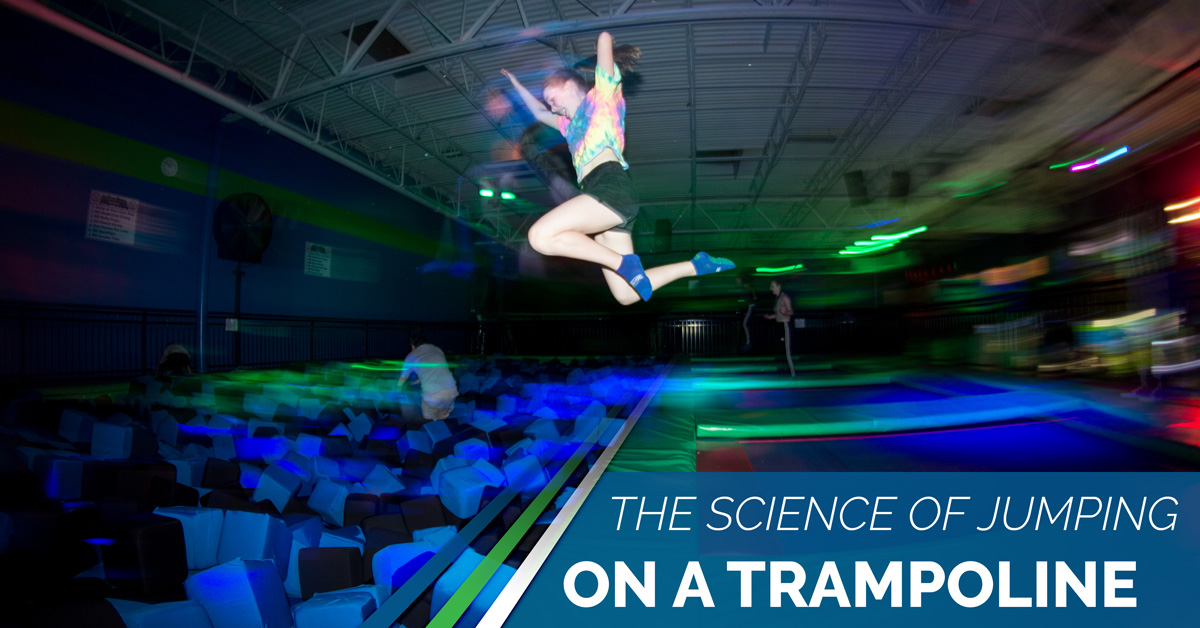ENJOY FREE ADMISSION EVERY DAY WHEN YOU PURCHASE A REBOUNDERZ MEMBERSHIP!

Call Us Now: (833) 832-1255
ENJOY FREE ADMISSION EVERY DAY WHEN YOU PURCHASE A REBOUNDERZ MEMBERSHIP!

Call Us Now: (833) 832-1255

Jumping. It’s something we all learn at a pretty early age. From jumping rope to leaping with reckless abandon into a big puddle, even just a few seconds off the ground is exhilarating no matter what your age. But when you give your natural jump just a little bit of a spring, defying gravity can come easy. That’s where a trampoline comes in. But how does it all work? We’re going to take a look at the science in play when you’re at play and what puts that extra bounce in your bounding. When you want to experience this physics phenomenon yourself, visit Rebounderz right here in Edison; the premiere trampoline park in New Jersey.
As shown by the sweat and sore muscles that come about after jumping on the trampoline, it’s no surprise how effective it is as an aerobic exercise. It has also been shown to improve cardiovascular health and coordination thanks to its engagement with the whole body. Regular trampoline use can even increase your body’s metabolism and by extension, its ability to burn calories efficiently. NASA has actually found jumping on a trampoline for 10 minutes has a more positive effect on your health and fitness than running for half an hour. It’s so effective, astronauts actually use it in their training before they go into space! Let’s face it, jumping is more fun than running, too.
So then, what makes a trampoline bouncy? Short answer: You. Long answer: Multiple different types of energy transfer, including gravitational potential energy, elastic energy, and kinetic energy. When you are standing still, you have potential energy. This is the same for the trampoline. Essentially, potential energy is energy that has been stored and is waiting to be unleashed. For the human body, much of our potential energy is represented by the food we eat, because that is what our body will convert into actual energy when we exert ourselves. For a trampoline, it stores its potential energy in its springs. When you use your potential energy to jump, the trampoline uses its potential energy in its springs to push back against you.
That all comes down to Newton’s Third Law of Motion; for every action, there is an equal and opposite reaction. When your body exerts its energy against the trampoline with the force of its legs pushing off the mat, the mat absorbs this action and then responds by sending that energy right back in the opposite direction with its elastic energy. That equal and opposite reaction is what pushes you up into the air.
You may not realize it, but your body has elastic energy too. Sure, you may not be made of rubber or springs, but the muscles inside your body act in much the same way. You build up elastic energy in your legs when you crouch down to jump, and it’s released when you jump up. Scientists even describe the act of preparing for a jump as coiling your tendons like springs. Your elastic energy acts against the trampolines elastic energy, which it has more of than you, resulting in a much larger reaction.
Kinetic energy is the energy of anything in motion, from you and your dog all the way down to the atoms in the air. Your kinetic energy is determined based on a combination of your weight and how fast you’re moving. This energy is then applied directly to the potential energy of what you are acting against, and its own kinetic energy helps determine what its reaction is.
That’s why something immobile like the ground doesn’t have the same reaction when you jump on it as something that absorbs (and therefore moves) like a trampoline. As you jump, you generate more kinetic and elastic energy, while exerting potential. This is why you can keep jumping higher despite not physically putting as much energy into it. You’re essentially riding the wave of the initial reaction while putting enough energy back in to continue the cycle.

The science of energy can get pretty amazing when you consider all of the forces acting and reacting to each other every second of every day. Our favorite part is how fun it is! If you’re looking for an opportunity to test your potential, elastic, and kinetic energy, why not give Rebounderz a call today? Located in Edison, we’ve got the best trampoline park you could want when you want to experiment with the bounds of physics. Jumping is just more fun on a trampoline.